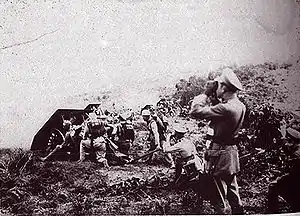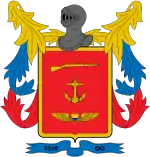Leticia Incident
The Leticia Incident, also called the Leticia War or the Colombia–Peru War (1 September 1932 – 24 May 1933), was a short-lived armed conflict between Colombia and Peru over territory in the Amazon rainforest. In the end, they reached an agreement to divide the disputed area between them.
| Colombia–Peru War | |||||||
|---|---|---|---|---|---|---|---|
 Colombian Army on manoeuvres during the conflict. | |||||||
| |||||||
| Belligerents | |||||||
|
|
| ||||||
| Commanders and leaders | |||||||
|
|
| ||||||
| Strength | |||||||
| 1,000 | 1,000 | ||||||
| Casualties and losses | |||||||
| 150-250 (mostly from jungle diseases) | 140-200 (mostly from jungle diseases) | ||||||
Background
Civilian takeover
The Colombia–Peru War was the result of dissatisfaction with the Salomón-Lozano Treaty and the imposition of heavy tariffs on sugar. The war started with an internal insurrection in Peru and a civilian takeover of the city of Iquitos.
On 1 September 1932, President Luis Miguel Sánchez dispatched two regiments of the Peruvian Army to Leticia and Tarapacá; both settlements were in the Amazonas Department, now in southern Colombia. Those actions were then mostly ignored by the Colombian government.
Colombian patriotism
It was not until 17 September that the Colombian government took notice. The Peruvian forces, which were encamped on the banks of the Putumayo River, stopped several large trade ships from traveling to Leticia.
The result was an explosion of Colombian patriotism. Laureano Gómez, the head of the Senate minority, proclaimed, "Peace, peace, peace in inner Colombia; war, war, war on the border against our despicable enemy."
On 19 September, El Tiempo reported that it had received over 10,000 letters calling for war and control of Leticia. The same day, thousands of Colombian students marched through the streets of Bogotá chanting, "Sánchez Cerro will die and Colombia will defy!" Vásquez Cobo was declared the general of the Colombian Amazonian Navy, and 10 million dollars were approved by the Senate to fund his venture. Over 400 kg of gold were donated by the Colombian cities as a symbol of gratitude to the Huilan engineer César García Álvarez.

Hostilities
Sánchez believed that Colombia had no chance of defending itself since it lacked roads in the Amazon and a proper navy due to financial hardships brought on by the Thousand Days War. It was not until December 1932 that General Alfredo Vásquez Cobo reached the mouth of the Amazon River with a fleet of old turn-of-the-century Colombian gun boats and new British destroyers that he acquired whilst in Europe. Within 90 days, Colombia organised a respectable military response to the Peruvian invasion. Herbert Boy and other German aviators of SCADTA, which later became Avianca, fitted their commercial planes for war as a temporary Colombian Air Force.
The first attack by the Colombian Navy was on Tarapacá. The city was chosen because Leticia was on the border with Brazil, and the Colombian Forces preferred to attack a softer target rather than the well-defended Peruvian positions in and around the city.
At the end of December 1932, the flotilla of ships acquired by Colombia arrived in the Amazon, but President Enrique Olaya Herrera did not authorize the use of these to recover Leticia, because he preserved the hope that a viable solution would be sought through diplomatic channels and avoid arriving. to the way of arms. For example, Brazil intervened by proposing settlement formulas and asked the Colombian government to park its boats in Manaus, while it was discussing with Peru[1]
The misgivings of the military were not absent in the war. General Rojas claimed command of operations in Belem do Pará, placing Vásquez Cobo in the background. The troops from Colombia, according to the latter, he received the old general with indifference. Olaya had awarded him the Cross of Boyacá but it was not enough. However, it was not just a matter of pride or prepotency. Vásquez Cobo wanted to immediately attack Leticia without taking into account of the guidelines that Rojas communicated to him. Olaya insisted on the assault on Tarapacá with two communiqués of January 20 and 28, 1933 and named Vásquez Cobo Minister of War on commission to overcome difficulties and place it, with all authority, above the military in service18. Vasquez Cobo then accepted Olaya's plan and expressed it in a message dated 5 February, accepting his march through Putumayo.[2]
On 14 February 1933, the Peruvian Air Force had attempted to bomb the Colombian Fleet, but most of the bombs hit their targets.[3]
The Peruvian forces in Leticia could not be forced to withdraw, but the events in Lima and the assassination of the Peruvian president changed the situation. The new Peruvian president ordered the undefeated Peruvian troops to leave Leticia. Part of Peru's Pacific fleet came through the Amazon River to engage in combat.
Rio de Janeiro Protocol
On the same day, Colombian President Enrique Olaya broke off all relations with Peru because of the aerial attack. He ordered an attack on Leticia, but it was repelled by Peruvian troops.
On 30 April 1933, Peruvian President Sánchez was shot dead; 15 days later, his successor, Óscar Benavides, met with the head of the Colombian Liberal Party, Alfonso López Pumarejo, to secure an agreement to turn Leticia over to a League of Nations commission.
Colombia and Peru met in Rio de Janeiro, Brazil, to sign a peace treaty. In the Rio de Janeiro Protocol, Peru stated, "We sincerely deplore the events that occurred starting September, 1932. Specifically those that damaged our relationship with Colombia." The Salomón-Lozano Treaty was also reaffirmed by the treaty.
References
- Samacá Alonso, Gabriel. "Santander History Center". Magazine of the National University of Colombia.
- Atehortúa Cruz, Adolfo León. "The Colombo - Peruvian Conflict". University of La Rioja, Spain.
- von Rauch 1984, p.6
- von Rauch, Herbert. "A South American Air War...The Letcia Conflict." Air Enthusiast. Issue 26, December 1984-March 1985. Bromley, Kent: Pilot Press. Pages 1–8. ISSN 0143-5450.
- AGN, Scadta,Informes sobre aviación militar 1931-1933. Minguerra, Caja 43, Carpeta 40, folios 96 y ss
- ARANCIBIA CLAVEL, Roberto (2002). La influencia del Ejército Chileno en América Latina 1900-1950. Santiago de Chile, Centro de Estudios e Investigaciones Militares CESIM.
External links
| Wikimedia Commons has media related to Colombia-Peru War. |
